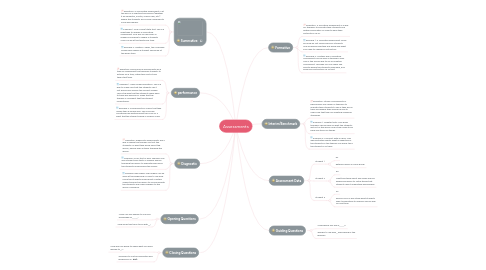Assessments
作者:Shelbie Gardner


1. Summative
1.1. Definition: A summative assessment is at the end of a selected time period (whether it be semester, month, school year, etc.) where the students are scored compared to some benchmark.
1.2. Example 1: End of year/state test. This is a great way to explain a summative assessment. And end of year exam is graded compared to where a students SHOULD be at that particular time.
1.3. Example 2: Midterm. Again, this is graded based upon where a student should be at the given time.
2. performance
2.1. Definition: Performance assessments are a type of assessment that requires students to actually do a task, rather than just sit and take a test/quiz.
2.2. Example 1: Open ended questions. This is a way to make sure that the students can't just guess and choose the correct answer. This is the way that the students really have to think and perform in a way that the teacher is confident that the student understands.
2.3. Example 2: Assignments in school that take longer than a simple quiz. This could be something like writing about the cycle of a plant that the students grew in science class.
3. Diagnostic
3.1. Definition: Diagnostic assessments are a way in which the teacher can test the students on what they know about the lesson, before ever actually teaching the lesson.
3.2. Example: A pre-test or quiz. Teachers can quiz students pre tests or quizzes before teaching the lesson to evaluate how much the students know before the lesson.
3.3. Example: Bell ringers. Bell ringers can be done at the beginning of class to see how much the students know about a certain subject before the lesson to accommodate the students and make changes to the lesson if need be.
4. Opening Questions
4.1. "How can you explain to me your knowledge of______"
4.2. "How does this topic tie in with ______"
5. Closing Questions
5.1. "How are you going to apply what you have learned to _______?"
5.2. "Describe to me the similarities and differences in ___ and ___"
6. Interim/Benchmark
6.1. Definition: Interim assessments or benchmarks are a way for teachers to evaluate their students to see if they are on track and where they should be and to make sure that they are meeting academic standards.
6.2. Example 1: Chapter tests. This gives teachers a good idea on what the students got out of the lesson and if they need to go back and touch on things.
6.3. Example 2: A project with a rubric. This demonstrates exactly what is expected of the students so the teacher can easily tell if the student is on track.
7. Formative
7.1. Definition: A formative assessment is a way for teachers to evaluate their students and gather information in order to base their instruction off of.
7.2. Example 1: A formative assessment could be done by just observing your students and assessing how they are doing and what you need to change in instruction.
7.3. Example 2: Another way a formative assessment can be done is through a quiz. This is the formal way to do a formative assessment. This way you can really see exactly where the students need help, and base your instruction off of that.
8. Assessment Data
8.1. Student 1
8.1.1. 64
8.1.2. Reteach lesson in small group
8.2. Student 2
8.2.1. 60
8.2.2. Next time think about bell ringer before beginning lesson to catch things that students didn't understand beforehand.
8.3. Student 3
8.3.1. 52
8.3.2. Really focus in and study what students didn't understand to improve lesson plan for next time.
